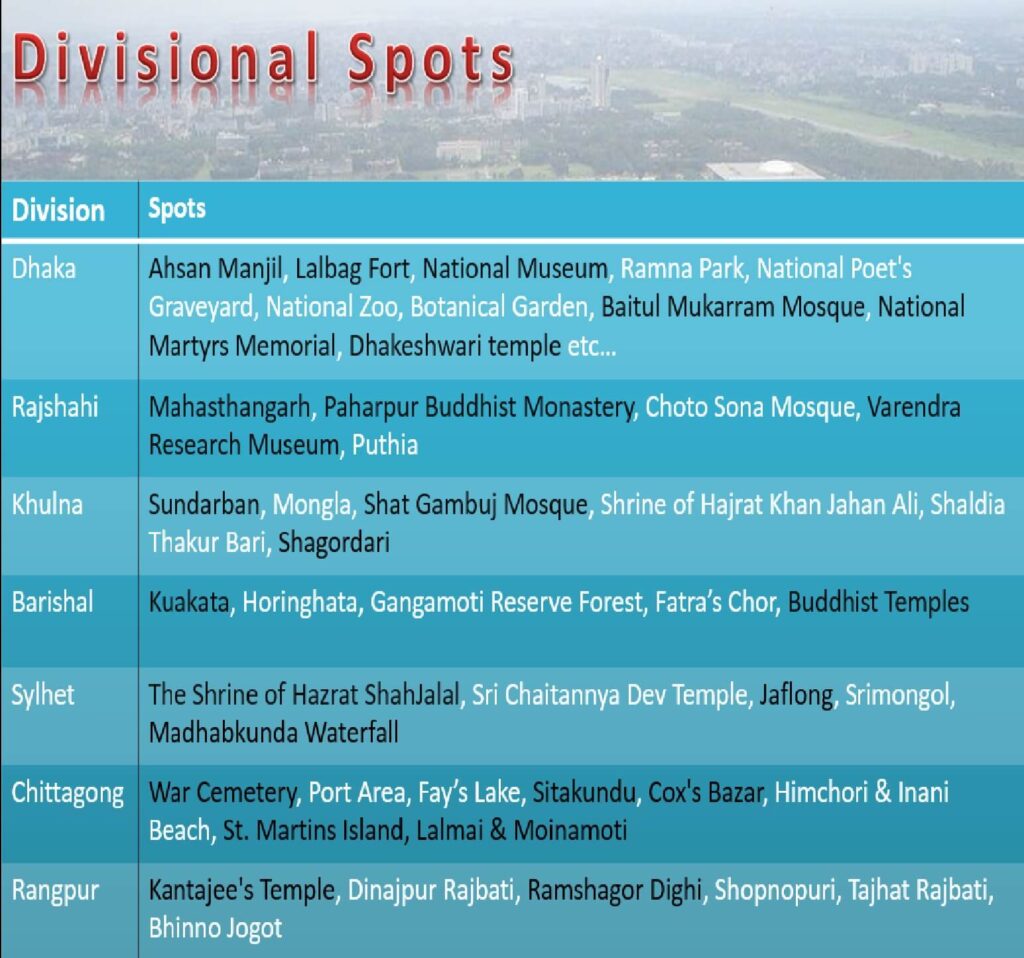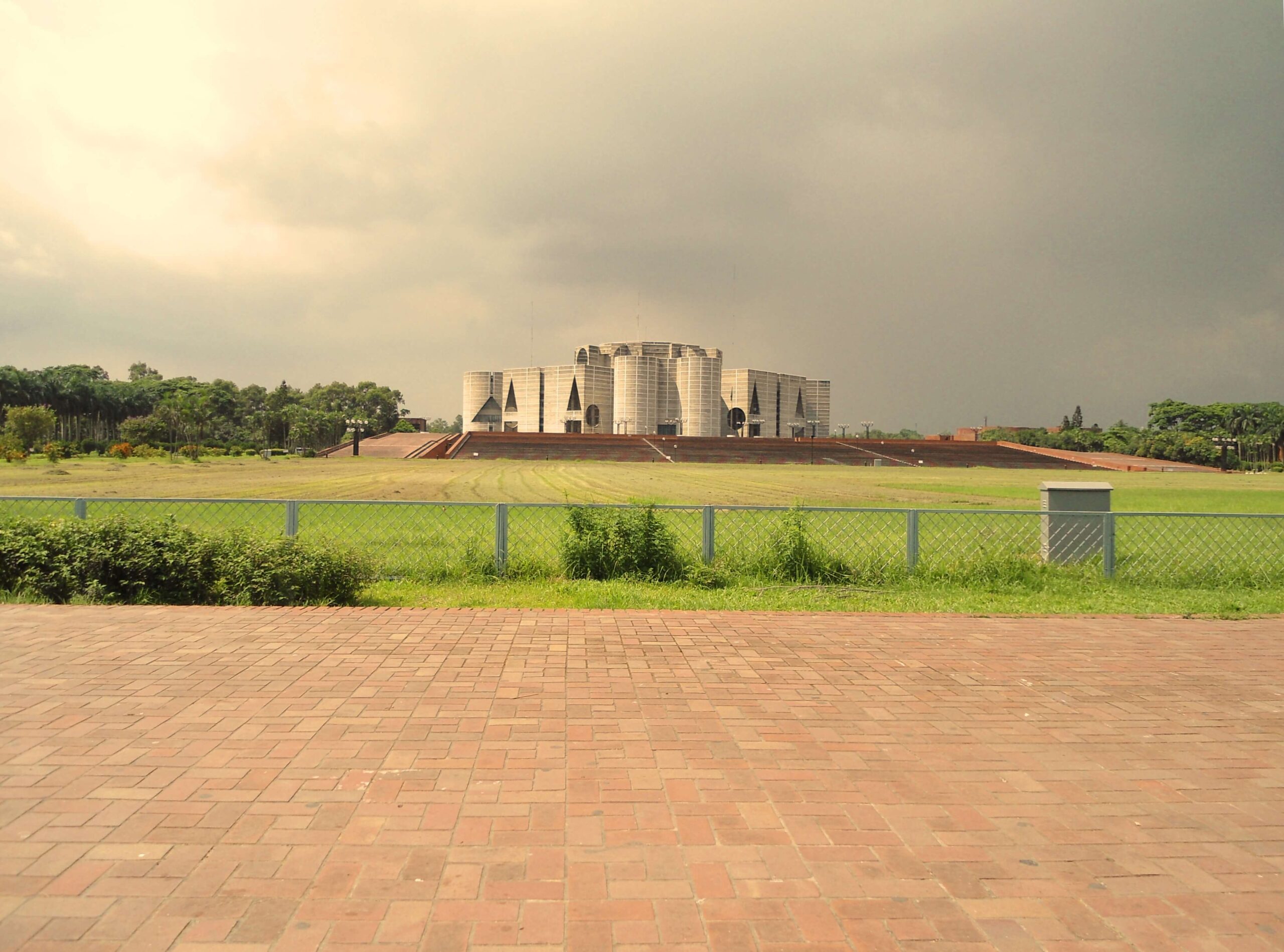Table of Contents
Tourism in Bangladesh offers a variety of experiences due to its rich cultural heritage, natural beauty, and historical landmarks. Although not as globally recognized as some of its neighboring countries, Bangladesh has unique attractions that draw visitors, including:

1. Natural Attractions
- Sundarbans Mangrove Forest: A UNESCO World Heritage Site, the Sundarbans is the largest mangrove forest in the world and home to the endangered Bengal tiger. It’s a major destination for eco-tourism and wildlife enthusiasts.
- Cox’s Bazar: Known for having the longest natural sea beach in the world, stretching over 120 km, Cox’s Bazar is a popular spot for beach lovers. The area is also famous for nearby attractions like Himchari National Park and Inani Beach.
- Saint Martin’s Island: The only coral island in Bangladesh, it offers a serene experience with crystal-clear waters and a peaceful environment, perfect for relaxation and snorkeling.
- Sajek Valley: Located in the Chittagong Hill Tracts, Sajek offers breathtaking views of rolling hills, lush greenery, and tribal culture. It has recently become a favorite destination for trekkers and nature lovers.
2. Cultural and Historical Sites
- Paharpur Buddhist Vihara: Another UNESCO World Heritage Site, this ancient Buddhist monastery is one of the largest and most important archaeological sites in South Asia. It offers insight into the country’s rich Buddhist past.
- Mahasthangarh: The oldest city in Bangladesh, Mahasthangarh dates back to the 3rd century BC and contains ruins from multiple civilizations, including Hindu, Buddhist, and Muslim.
- Lalbagh Fort: This Mughal-era fort in Dhaka is a key historical site, known for its impressive architecture and the tales of its unfinished construction.
3. Rivers and Waterways
- Bangladesh is a riverine country, and its rivers play a significant role in tourism. River cruises on the Padma, Meghna, and Jamuna rivers offer beautiful views of the countryside and rural life.
- Kuakata Beach: Known as the “Daughter of the Sea,” Kuakata offers panoramic views of both sunrise and sunset over the Bay of Bengal.
4. Cultural Festivals
- Pohela Boishakh (Bengali New Year): Celebrated with great enthusiasm, especially in Dhaka, it’s a fantastic time to experience local traditions, parades, and Bengali cuisine.
- Durga Puja: A major festival for the Hindu community, celebrated with grandeur, especially in cities like Dhaka and Chittagong.
5. Tribal and Indigenous Experiences
- In the Chittagong Hill Tracts, visitors can interact with indigenous communities like the Chakma, Marma, and Tripuri. The region’s natural beauty is complemented by the unique cultural heritage of these tribes.
6. Dhaka: The Capital City
- Dhaka is a city of contrasts, with its blend of modernity and tradition. Key attractions include:
- Ahsan Manzil: A pink palace that served as the official residence of the Nawabs of Dhaka.
- National Parliament House: An architectural marvel designed by renowned architect Louis Kahn.
- Old Dhaka: A bustling area filled with narrow streets, markets, and historical landmarks like Armenian Church, Star Mosque, and the Tara Masjid.
Bangladesh‘s tourism is a hidden gem, offering an authentic experience for those looking to explore off the beaten path, combining nature, history, and culture.
Challenges in Tourism in Bangladesh
Despite its potential, Bangladesh’s tourism industry faces challenges like inadequate infrastructure, limited global marketing, and seasonal climate issues (monsoons). However, the country is gradually improving its facilities and accessibility to attract more international visitors.
1. Infrastructure Deficiencies
The lack of modern infrastructure is a major barrier to tourism development in Bangladesh. Inadequate road networks, poor public transportation, and limited connectivity to remote tourist destinations, such as the Sundarbans and Chittagong Hill Tracts, make travel difficult and time-consuming for tourists.
2. Marketing and Promotion
Bangladesh struggles with promoting itself as a tourist destination internationally. The country is often overshadowed by neighboring destinations like India and Thailand, which invest heavily in tourism marketing. A lack of global awareness of Bangladesh’s attractions, combined with limited promotional campaigns, results in fewer international tourists.
3. Safety Concerns and Political Instability
Political instability and concerns over safety have also negatively impacted tourism in Bangladesh. Strikes, protests, and occasional security issues create uncertainty for tourists, especially for those unfamiliar with the local situation.
4. Environmental and Climate Vulnerabilities
As a low-lying country, Bangladesh is highly vulnerable to climate change, including rising sea levels, floods, and cyclones. These environmental challenges disrupt travel plans and damage tourist destinations, particularly during the monsoon season, which reduces the peak tourism window.
5. Lack of Skilled Manpower and Services
Bangladesh’s tourism industry lacks adequately trained professionals in hospitality and tourism services. Poor customer service, limited language proficiency, and insufficient information for tourists, particularly in rural areas, create barriers to a smooth visitor experience.
Addressing these challenges through improved infrastructure, effective marketing, enhanced safety measures, and capacity building is essential for unlocking Bangladesh’s tourism potential.
wiki say’s: Tourism in Bangladesh includes tourism to World Heritage Sites, historical monuments, resorts, beaches, picnic spots, forests, tribal people, and wildlife of various species. Activities for tourists include angling, water skiing, river cruising, hiking, rowing, yachting, beachgoing and sea bathing.

Leave a Reply